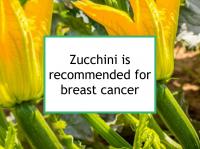Zucchini (Cucurbita pepo Zucchini), also known as courgette, is a variety of summer squash. This category also includes yellow crookneck, pattypan, scallop and yellow summer squash. Yellow-fleshed winter squash such as acorn, butternut, or spaghetti squash are covered under the pumpkin webpage.
Zucchini is a good source of lutein & zeaxanthin, as well as cucurbitacin B & cucurbitacin E. Zucchini is also a source of enterolactone and vitamin C, and contains some beta-carotene, all of which have been linked to lower risk of breast cancer.
Breast cancer-related effects of eating zucchini
One Korean case-control study comparing the diets of breast cancer patients with a healthy control group found that the breast cancer patients consumed a significantly lower quantity of zucchini, among other foods, than the controls. However, evidence that zucchini could be beneficial in fighting breast cancer is derived mainly from studies of zucchini compounds. Numerous studies have found an inverse association between breast cancer risk and high dietary levels of carotenoids such as lutein and zeaxanthin. Cucurbitacins have also been shown to have anti-breast cancer effects.
Lutein & zeaxanthin
Lutein and zeaxanthin have identical chemical composition but slightly different molecular structures (they are chemical isomers). These structural differences can result in slightly different activities in the body. Lutein and zeaxanthin are often found in the same food, however one usually predominates. Zucchini has a higher fraction of lutein than zeaxanthin.
Lutein and zeaxanthin intake has been found to be associated with reduced risk of breast cancer in multiple studies. For example, one study reported an inverse association between high levels of lutein/zeaxanthin consumption over five years and breast cancer risk among premenopausal women. Another study found that intake of lutein/zeaxanthin was inversely associated with risk of ER-, but not ER+, breast cancer. However, not all population studies have found a link.
Lutein has been demonstrated to reduce the viability of ER+/PR+ and triple negative (ER-/PR-/HER2-) cells by activating programmed cell death through antioxidant defense response-linked cell survival signaling. Lutein has also been shown to inhibit the progression of both ER+/PR+ and triple negative breast cancer cells under hypoxia, a low-oxygen condition in which solid breast tumors can thrive. In addition, lutein has been shown to potentiate the effect of taxane chemotherapy drugs (paclitaxel and docetaxel) in breast cancer cells.
Zeaxanthin has been reported to induce programmed cell death in triple negative breast cancer cells made resistant to chemotherapy through one type of multidrug resistance protein, MDR-1. MDR proteins are present in a majority of human tumors and are an important cause of eventual treatment failure.
Cucurbitacins
Cucurbitacin B and cucurbitacin E are bitter compounds found in modest amounts in zucchini — zucchini has been cultivated to minimize its cucurbitacin content and the associated bitterness and toxicity. Zucchini skin is a better source of cucurbitacins than the flesh and green zucchinis have a higher content than yellow (golden) varieties. Cucurbitacins are not destroyed by cooking.
Cucurbitacin B
Cucurbitacin B has been shown to inhibit the growth and proliferation of ER+/PR+, HER2+ and triple negative cells, as well as cells with BRCA1 mutations. A tiny amount of cucurbitacin B was found to halve tumor volume without harming the animals in an experiment using a mouse model of triple negative breast cancer.
A low dose of cucurbitacin B was also shown to enhance the treatment effects of docetaxel in another mouse model of triple negative breast cancer, without toxicity to the animals.
Cucurbitacin E
Cucurbitacin E has been shown to induce cell cycle arrest and apoptosis in ER+/PR+ and triple negative breast cancer cells. In addition, cucurbitacin E has been demonstrated to reduce metastasis by inhibiting cell migration and invasion in a mouse model of triple negative breast cancer.
There is some evidence that cucurbitacin E can improve treatment of multidrug-resistant breast cancer cells by targeting EGFR and silencing its downstream signaling paths. In fact, cucurbitacin E has been reported to increase the treatment effects of doxorubicin in ovarian cancer cells.
Bitter Cucurbitaceae
Colocynth (Citrullus colocynthis), also known as bitter apple or bitter cucumber, and bitter Hawkesbury watermelon (Citrullus lanatus), which are both related to watermelon, have a much higher fraction of cucurbitacins than zucchini or any other common food. High-cucurbitacin extracts of these fruits are sometimes sold as herbal remedies, including for cancer. However, while chemotherapy based on cucurbitacins may eventually be developed, these are toxic chemicals whose safety profiles and appropriate dosages have not been determined. Cucurbitacin supplements are not recommended.
Additional comments
Back mutation of zucchini to a more bitter variety containing relatively high levels of cucurbitacins occasionally occurs. Such reversion to form can occur when gardeners harvest and use their own zucchini seeds, especially if the zucchini which was the source of seeds was planted near ornamental pumpkins or gourds. These ornamental varieties, which have not been bred to be edible, tend to be high in cucurbitacins and can cross-fertilize edible Cucurbitaceae plants such as zucchini. Consuming such back-mutated zucchini can results in severe cramps, vomiting, persistent diarrhea or outright poisoning.
However, note that commercially grown and processed zucchini also has occasionally resulted in cucurbitacin poisoning. Therefore, zucchini with a noticeably bitter taste (whether fresh, canned or frozen) should be avoided.
Sources of information provided in this webpage
The information above, which is updated continually as new research becomes available, has been developed based solely on the results of academic studies. Clicking on any of the underlined terms will take you to its tag or webpage, which contain more extensive information.
Below are links to 20 recent studies concerning this food and its components. For a more complete list of studies, please click on zucchini.
